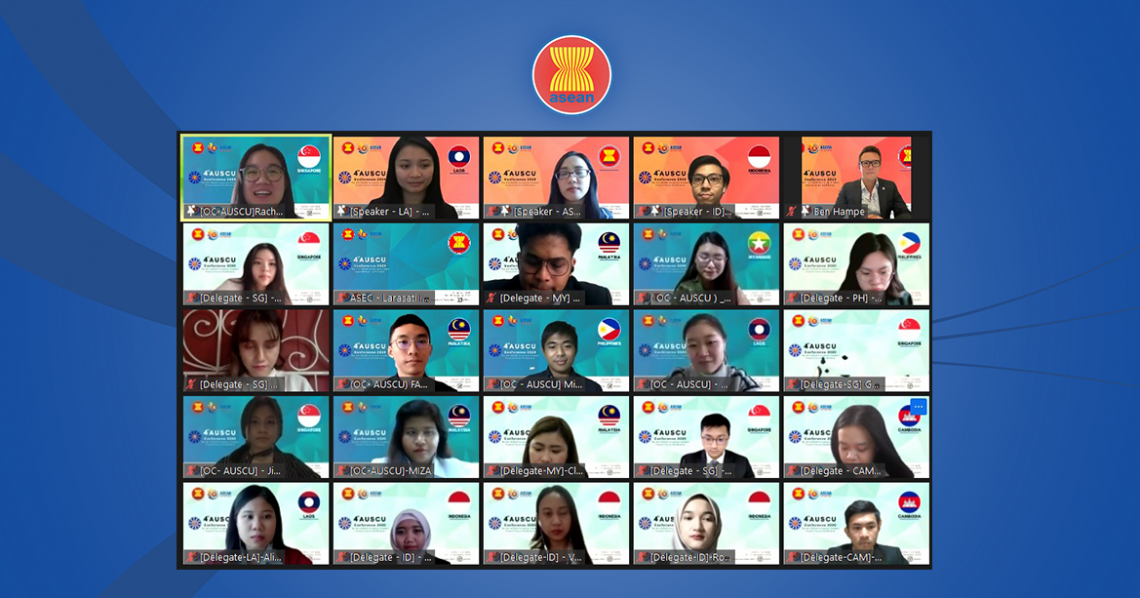HA NOI, 18 December 2020 – The ASEAN University Student Council Union (AUSCU), supported by Viet Nam’s National Committee on Youth, organised its fourth conference on 10 -11 December.
The virtual conference’s theme was ASEAN Youth with ASEAN Identity: Raising Awareness and Taking Action for a Cohesive and Responsive Community. Over 60 student leaders across the region worked together to develop recommendations on fostering an ASEAN identity in support of ASEAN Community building. Representatives of the ASEAN Senior Officials Meeting on Youth also took part in the conference as advisors.
Secretary of the Youth Union and Viet Nam’s President of Student Union Bui Quang Huy opened the conference. On her part, Director of Human Development Directorate at the ASEAN Secretariat Rodora T. Babaran spoke about ASEAN youth sector’s work and priorities. Meanwhile, AUSCU President Marie Lan Anh Ngo explained the mandate of the organisation and presented the objectives of the conference.
Through plenary discussions and mini workshops, the conference enabled student leaders to unpack the notion of ASEAN identity. Student leaders explored the importance of a common regional identity in mobilising youth to contribute to ASEAN Community building. They also discussed the role of ASEAN identity in addressing regional challenges, diplomacy as a tool for communication, and ASEAN readiness for the Fourth Industrial Revolution. Further, they presented policies and programmes benefiting higher education students in their respective countries.
In a panel discussion on how youth can find an ASEAN identity from within, Siriphone Siriphongphanh, Global UGRAD fellow and eMpowering Youths Across ASEAN Alumni shared that “ASEAN identity is like a set of beautiful, colourful cultures mixed together, with culture and language developing friendships and kinships as one.”
A workshop on “Unity in Diversity” stimulated exchange on each nation’s history, culture and values. Student delegates and advisors discussed the cultural elements that shape the identity of each nation and identified common values among ASEAN Member States.
In another discussion, Product Manager of inSTEDD iLab Southeast Asia Chandy Mao highlighted that “we, as the youth of ASEAN who are living in the same region and facing similar problems, need to embrace the fact that we are part of the problem. We should therefore take part in solving those problems.”
The conference also featured a mini workshop led by John Derrick Ordoñez, the first AUSCU President. He introduced the concept of transformational leadership and urged student delegates to inspire, influence, and advocate in order to build a cohesive and responsive ASEAN Community. In the same vein, Louise Mabulo, Founder of The Cacao Project, underscored that youth need to actively shape the future of ASEAN by working on continuous self-improvement, confronting challenges, and starting to take on responsibility.
At the end of conference, student leaders drafted recommendations based on their discussions. AUSCU will submit these recommendations to the ASEAN Senior Officials Meeting on Youth.
The fourth AUSCU Conference is one of the key youth events organised by Viet Nam as part of their 2020 ASEAN Chairship. The conference theme was selected in light of 2020 being designated as the Year of ASEAN Identity.
AUSCU was founded by student leaders at the Japan East-Asia Network of Students and Youths Programme (JENESYS) 2016 Student Conference. The first AUSCU conference took place in 2017, in commemoration of ASEAN’s 50th anniversary. In the same year, the establishment of AUSCU was approved by the ASEAN youth sector.
Selected sessions of the fourth AUSCU conference may be viewed here:
Opening Session – https://fb.watch/2nfppmvdkO/
First Day – https://fb.watch/2nfqHa0IF1/
- ABOUT ASEANThe Association of Southeast Asian Nations, or ASEAN, was established on 8 August 1967 in Bangkok, Thailand, with the signing of the ASEAN Declaration (Bangkok Declaration) by the Founding Fathers of ASEAN: Indonesia, Malaysia, Philippines, Singapore and Thailand. Brunei Darussalam joined ASEAN on 7 January 1984, followed by Viet Nam on 28 July 1995, Lao PDR and Myanmar on 23 July 1997, and Cambodia on 30 April 1999, making up what is today the ten Member States of ASEAN.Menu
- WHAT WE DO
ASEAN organs always strive to achieve ASEAN’s goals and objectives, the Secretary-General of ASEAN and the ASEAN Secretariat shall be functioned as coordinating Secretariat to help facilitate effective decision-making withing and amongst ASEAN bodies. In addition, each Member State shall appoint a Permanent Representative to liaise with Secretary-General of ASEAN and the ASEAN Secretariat
Menu - WHO WE WORK WITH
ASEAN shall develop friendly relations and mutually beneficial dialogues, cooperation and partnerships with countries and sub-regional, regional and international organisations and institutions. This includes external partners, ASEAN entities, human rights bodies, non-ASEAN Member States Ambassadors to ASEAN, ASEAN committees in third countries and international organisations, as well as international / regional organisations.
Menu - OUR COMMUNITIES
The rodmap for an ASEAN Community (2009-2015) was declared by the leaders in 2009. The ASEAN Community, anchored on three community pillars: Political-Security Community, Economic Community, Socio-Cultural Community was launched in 2015. The ASEAN 2025: Forging Ahead Together was introduced in 2015 as a Post-2015 Vision. It comprises the ASEAN Community Vision 2025, the ASEAN Political-Security Community Blueprint 2025, the ASEAN Economic Community Blueprint 2025 and the ASEAN Socio-Cultural Community Blueprint 2025
Menu - SITEMAP





